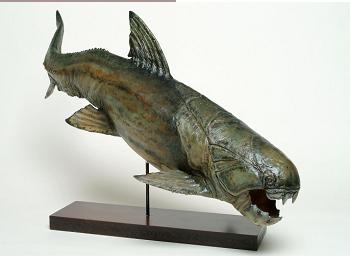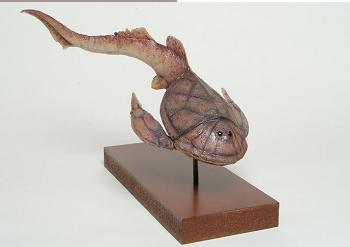click images for larger views
Prehistoric fish are various groups of fishes that lived before recorded history. A few, such as the coelacanth still exist today and are considered living fossils.
The first fish and indeed the first vertebrates, were the ostracoderms, which appeared in the Cambrian Period, about 510 million years ago, and became extinct at the end of the Devonian, about 350 million years ago. Ostracoderms were jawless fishes found mainly in fresh water. They were covered with a bony armor or scales and were often less than 30 cm (1 ft) long. The ostracoderms are placed in the class Agnatha along with the living jawless fishes, the lampreys and hagfishes, which are believed to be descended from the ostracoderms.
The first fishes with jaws, the acanthodians, or spiny sharks, appeared in the late Silurian, about 410 million years ago, and became extinct before the end of the Permian, about 250 million years ago. Acanthodians were generally small sharklike fishes varying from toothless filter-feeders to toothed predators. They are often classified as an order of the class Placodermi, another group of primitive fishes, but recent authorities tend to place the acanthodians in a class by themselves (class Acanthodii) or even within the class of modern bony fishes, the Osteichthyes. It is commonly believed that the acanthodians and the modern bony fishes are related and that either the acanthodians gave rise to the modern bony fishes or that both groups share a common ancestor.
The placoderms, another group of jawed fishes, appeared at the beginning of the Devonian, about 395 million years ago, and became extinct at the end of the Devonian or the beginning of the Mississippian (Carboniferous), about 345 million years ago. Placoderms were typically small, flattened bottom-dwellers. The upper jaw was firmly fused to the skull, but there was a hinge joint between the skull and the bony plating of the trunk region.
The cartilaginous-skeleton sharks and rays, class Chondrichthyes, which appeared about 370 million years ago in the middle Devonian, are generally believed to be descended from the bony-skeleton placoderms. The cartilaginous skeletons are considered to be a later development.
The modern bony fishes, class Osteichthyes, appeared in the late Silurian or early Devonian, about 395 million years ago. The early forms were freshwater fishes, for no fossil remains of modern bony fishes have been found in marine deposits older than Triassic time, about 230 million years ago. The Osteichthyes may have arisen from the acanthodians. A subclass of the Osteichthyes, the ray-finned fishes (subclass Actinopterygii), became and have remained the dominant group of fishes throughout the world. It was not the ray-finned fishes, however, that led to the evolution of the land vertebrates.
The ancestors of the land vertebrates are found among another group of bony fishes called the Choanichthyes or Sarcopterygii. Choanate fishes are characterized by internal nostrils, fleshy fins called lobe fins, and cosmoid scales. The choanate fishes appeared in the late Silurian or early Devonian, more than 390 million years ago, and possibly arose from the acanthodians. The choanate fishes include a group known as the Crossopterygii, which has one living representative, the coelacanth (Latimeria). During the Devonian Period some crossopterygian fishes of the order (or suborder) Rhipidistia crawled out of the water to become the first amphibians.
The first fish and indeed the first vertebrates, were the ostracoderms, which appeared in the Cambrian Period, about 510 million years ago, and became extinct at the end of the Devonian, about 350 million years ago. Ostracoderms were jawless fishes found mainly in fresh water. They were covered with a bony armor or scales and were often less than 30 cm (1 ft) long. The ostracoderms are placed in the class Agnatha along with the living jawless fishes, the lampreys and hagfishes, which are believed to be descended from the ostracoderms.
The first fishes with jaws, the acanthodians, or spiny sharks, appeared in the late Silurian, about 410 million years ago, and became extinct before the end of the Permian, about 250 million years ago. Acanthodians were generally small sharklike fishes varying from toothless filter-feeders to toothed predators. They are often classified as an order of the class Placodermi, another group of primitive fishes, but recent authorities tend to place the acanthodians in a class by themselves (class Acanthodii) or even within the class of modern bony fishes, the Osteichthyes. It is commonly believed that the acanthodians and the modern bony fishes are related and that either the acanthodians gave rise to the modern bony fishes or that both groups share a common ancestor.
The placoderms, another group of jawed fishes, appeared at the beginning of the Devonian, about 395 million years ago, and became extinct at the end of the Devonian or the beginning of the Mississippian (Carboniferous), about 345 million years ago. Placoderms were typically small, flattened bottom-dwellers. The upper jaw was firmly fused to the skull, but there was a hinge joint between the skull and the bony plating of the trunk region.
The cartilaginous-skeleton sharks and rays, class Chondrichthyes, which appeared about 370 million years ago in the middle Devonian, are generally believed to be descended from the bony-skeleton placoderms. The cartilaginous skeletons are considered to be a later development.
The modern bony fishes, class Osteichthyes, appeared in the late Silurian or early Devonian, about 395 million years ago. The early forms were freshwater fishes, for no fossil remains of modern bony fishes have been found in marine deposits older than Triassic time, about 230 million years ago. The Osteichthyes may have arisen from the acanthodians. A subclass of the Osteichthyes, the ray-finned fishes (subclass Actinopterygii), became and have remained the dominant group of fishes throughout the world. It was not the ray-finned fishes, however, that led to the evolution of the land vertebrates.
The ancestors of the land vertebrates are found among another group of bony fishes called the Choanichthyes or Sarcopterygii. Choanate fishes are characterized by internal nostrils, fleshy fins called lobe fins, and cosmoid scales. The choanate fishes appeared in the late Silurian or early Devonian, more than 390 million years ago, and possibly arose from the acanthodians. The choanate fishes include a group known as the Crossopterygii, which has one living representative, the coelacanth (Latimeria). During the Devonian Period some crossopterygian fishes of the order (or suborder) Rhipidistia crawled out of the water to become the first amphibians.
[News] [Life-Size Sculptures] [Model Kits] [Wildlife Collection] [Complete Catalog] [About Us] [Contact Us]
[Frequent Questions] [The Studio At Work] [Links] [Privacy Policy] [Terms of Use]
© 2017 CM Studio
All Rights Reserved
CM Studio 100 West Central Avenue Benld, Illinois 62009
mail@cmstudio.com
[Frequent Questions] [The Studio At Work] [Links] [Privacy Policy] [Terms of Use]
© 2017 CM Studio
All Rights Reserved
CM Studio 100 West Central Avenue Benld, Illinois 62009
mail@cmstudio.com




